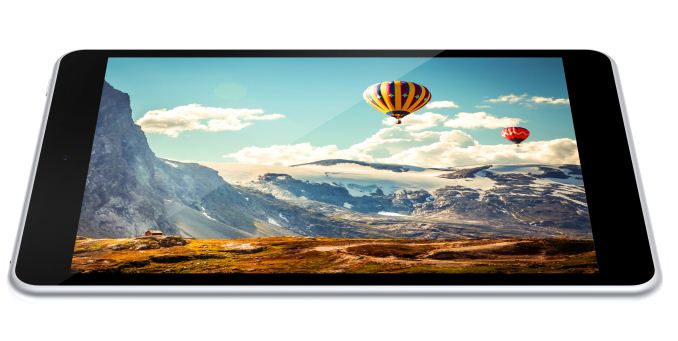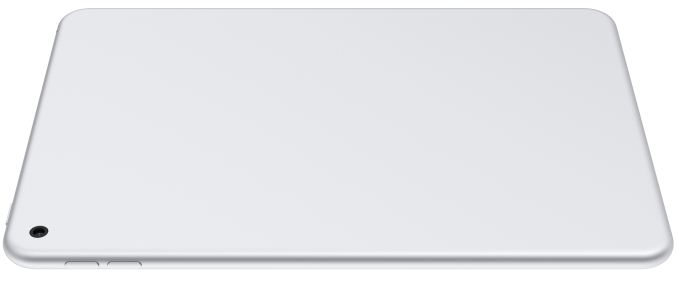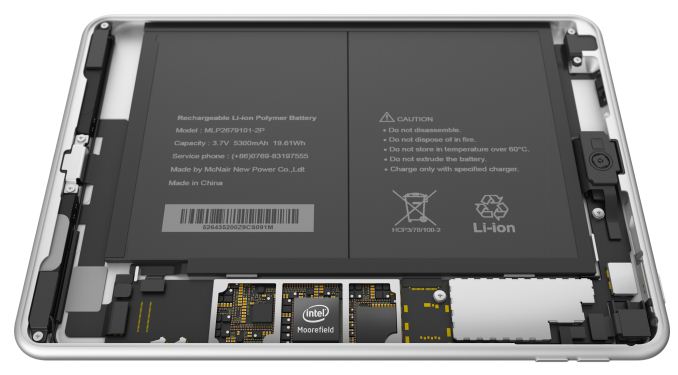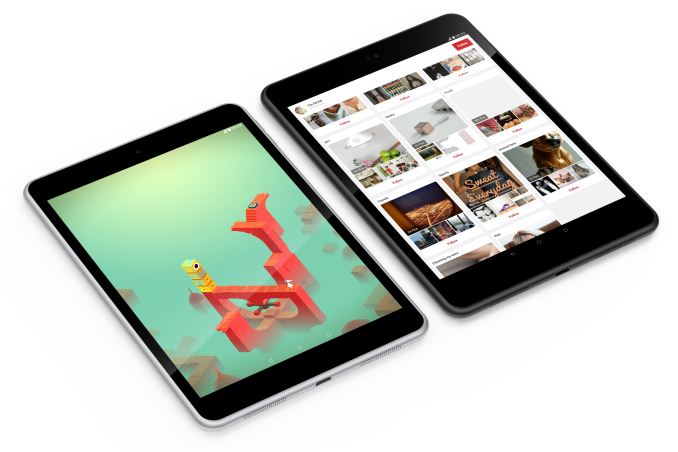Nokia Announces N1 Tablet: 7.9” & Powered By Android
by Ryan Smith on November 18, 2014 7:30 AM EST
Since selling their mobile device division to Microsoft, much contemplation has been had over the future of Nokia. As it slowly turns out, their future is not all that different from the past. Except perhaps that there’s a lot more Android in Nokia’s future.
As part of the Slush 2014 conference, Nokia has announced their next consumer gadget, a new tablet going by the name Nokia N1. Measuring at 7.9” diagonal, powered by an Intel CPU, and running Android Lollipop, the N1 is Nokia’s first tablet since selling their mobile device division.
From a design perspective I’m not sure there’s anything to call the N1 other than an unabashed duplicate of the iPad Mini. Built out of a single piece of aluminum, the N1 incorporates the iPad’s 7.9” diagonal size and many of its stylings, including curves, button placements, and even the location of the headphone jack. Short of the iPad’s home button, at first glance you would be hard pressed to tell the N1 and iPad Mini apart.
In any case, while in many ways Nokia is looking to learn from the masters here, the N1’s design does have some elements that set it apart (and ahead) of the iPad Mini and similar tablets. Nokia has been able to drive the tablet to just 6.9mm thick and 318g heavy – thinner and lighter than any iPad Mini. Meanwhile the display has been fully laminated, with Nokia eliminating any kind of air gap between the display panel and the cover glass.
In terms of technical specifications Nokia is tapping Intel’s Atom Z3580 to power the device. Z3580 includes a quad-core Silvermont processor running at 2.3Ghz, along with an Imagination PowerVR G6430 running at 533MHz. Paired with the processor is 2GB of LPDDR3-1600, Bluetooth 4.0, and 802.11ac WiFi. Meanwhile the 7.9” 4:3 IPS display is 2048x1536 pixels, once again identical to the retina iPad Mini. Powering the device will be an 18.5Whr battery.
| Tablet Specificaiton Comparison | |||
| Nokia N1 | iPad Mini 3 | NVIDIA SHIELD Tablet | |
| SoC | Intel Atom Z3580 | Apple A7 | Tegra K1 |
| CPU | 4x Silvermont @ 2.3Ghz | 2x Cyclone @ 1.3GHz | 4x Cortex A15r3 @ 2.2GHz |
| GPU | PowerVR G6430 @ 533MHz | PowerVR G6430 | Kepler (1 SMX) |
| RAM | 2GB LPDDR3-1600 | 1GB LPDDR3 | 2GB DDR3L-1866 |
| NAND | 32GB NAND (eMMC 5.0) | 16GB/64GB/128GB NAND | 16GB/32GB NAND + microSD |
| Display | 7.9" 2048 x 1536 IPS LCD | 7.9" 2048 x 1536 IPS LCD | 8” 1920 x 1200 IPS LCD |
| Dimensions | 200.7 x 138.6 x 6.9mm, 318 grams | 200 x 134.7 x 7.5mm, 331 grams | 221 x 126 x 9.2mm, 390 grams |
| Camera | 8MP Rear Camera 5MP FFC |
5MP Rear Camera 1.2MP FFC |
5MP Rear Camera 5MP FFC |
| Battery | 5300 mAh, 3.7V chemistry (19.61 Whr) | 23.8Whr | 5197 mAh, 3.8V chemistry (19.75 Whr) |
| OS | Android 5.0 + Nokia Z Launcher |
iOS 8 | Android 4.4.2 |
| Connectivity | 802.11a/b/g/n/ac + BT 4.0, USB Type-C (USB 2.0) | 802.11a/b/g/n + BT 4.0, Lightning (USB 2.0) | 2x2 802.11a/b/g/n + BT 4.0, USB2.0, mini HDMI 1.4a |
| Price | $249 (32GB) | $399 (16GB) $499 (64GB) |
$299 (16GB/WiFi) $399 (32GB/LTE) |
One notable first here, Nokia is utilizing the new USB Type-C connector for the tablet, and not entirely in the way we’d expect. With the Type-C connector serving as Nokia’s analogue to Apple’s Lightning, Nokia is using what they call a “Micro-USB 2.0 with a Type-C reversible connector” setup, which means that while this is a Type-C connector it is only wired up for USB 2.0 and not USB 3.0. Given the design goals of the Type-C connector, we expect this will be the first of many such mobile devices to make use of it in the coming months.
Vision for the N1 will be provided by a pair of cameras on the front and back. The rear camera is an 8MP camera with autofocus and is capable of recording video at 1080p. Meanwhile the smaller front camera is 5MP and utilizes fixed focus. Finally, the tablet comes in a single storage configuration of 32GB, with Nokia’s NAND driven through eMMC 5.0.
On the software side of matters, the N1 will run a semi-customized version of Android Loliipop. In this case Nokia has made only a handful of changes, primarily replacing the standard Android launcher with their newly released Z Launcher.
Finally, while the N1 is a Nokia branded product, Nokia is calling special attention to their manufacturing arrangement with tablet partner Foxconn. As part of Nokia’s development strategy, the industrial design, IP, and Z Launcher software are being licensed to Foxconn for the production of the tablet. Foxconn in turn basically assumes all further responsibilities for the product, including business execution, engineering, and support, in many ways making this a Foxconn tablet with Nokia software and branding.
No doubt due in part to this reason, the N1 will be launching first in China before coming to other regions. Nokia’s official announcement states that it will be launching in China in Q1’15 for the equivalent of $249 USD (before taxes) with no further markets announced at this time. Meanwhile BGR is reporting that it is expected to launch in China after Chinese New Year, with further releases in Russia and parts of Europe in the following months. To that end there are no currently announced plans to bring the N1 to North America, though at this stage by no means does it mean that the N1 won’t come at a later date.
Source: Nokia




















54 Comments
View All Comments
darkich - Tuesday, November 18, 2014 - link
Trust me, you don't want to use Windows on a 1440p 8" screen.And may I ask an example of an app that you would use on a this device, with a mouse and a keyboard?
darkich - Tuesday, November 18, 2014 - link
Btw, I have a Bluetooth keyboard and mouse that seamlessly connect to my android tablet, and work as a charm. Power up and go.Of course, plugging in an USB over the micro USB adapter works just as on Windows
darkich - Tuesday, November 18, 2014 - link
Correction (darn you anandtech and your ancient comment system).. the question in my first reply regarding the app example used with keyboard and a mouse was for Windows tablet, not this tablet.name99 - Tuesday, November 18, 2014 - link
"You can even do serious Java programming, video editing, and 3D modelling on an android device now."Just because you can, WTF would you want to? Any normal human being would 10x more productive programming Java on an appropriate machine (at least 13" laptop, ideally a desktop with a 27" screen or larger). Decent keyboard, chording shortcuts, massive screen space for comparing text, looking things up, and viewing debugging state are all essential to modern programming.
Are you really so poor that you can't afford to buy the right tool to do the job (even if you could pick up a second hand version of that tool on eBay for probably $200 if you really had to)? Do you also own only one plate, one pair of shoes, and one pair of trousers?
darkich - Wednesday, November 19, 2014 - link
Haha, thanks for proving my point!And my point was that, when it comes to small tablets, there really is no real advantage in having windows on it.
Android is perfectly good for content consumption and gaming and everything that would be reasonable to do an such form factor.
The supposed advantages of Windows really don't make sense here.
"Oh but you can run 3D Max and Photoshop and all the legacy Windows games "!
Good luck with that
Walkop - Tuesday, November 18, 2014 - link
Why is no-one mentioning how INSANELY IMPRESSIVE this is for $249? Especially the Type-C, EMMC 5.0, 64-bit Intel SoC, thin and light (and metal)…Death666Angel - Tuesday, November 18, 2014 - link
EMMC 5.0 doesn't mean anything for performance. It can be good, but just as there are SATA III SSDs that suck and USB3.0 sticks that suck, so can NAND connected via EMMC 5.0. Intel SoC is fine, but likely not much better or worse than competing nVidia and Qualcomm solutions. Type C is a nice to have feature, but people have been getting by with micro USB for 5 years now and all they make use of is the reversibility, no need for a higher power draw and no faster connectivity than USB 2.0. It being thin and light has been mentioned quite clearly.However, if you hadn't said it, I would not have known about it being all metal. I was assuming a metal strip at the most, considering that Nokia is fond of their polycarbonate designs. Weird for Anandtech not to gush over a metal tablet. :Drepoman27 - Tuesday, November 18, 2014 - link
Why would using the Type-C connector result in higher power draw? This is just USB 2.0 using a Type-C connector instead of Micro-AB.Despite Ryan's comment that, "Nokia is utilizing the new USB Type-C connector for the tablet, and not entirely in the way we’d expect," this is exactly how I expected the Type-C connector to be used. It's not part of the USB 3.1 or even 3.0 specs, it's a new and much improved connector designed to replace the Micro-B variants. And personally, I was pretty excited to finally see a product announced that actually uses the new connector.
One additional potential upside to using Type-C is that the spec includes an Audio Adapter Accessory Mode, which this tablet might support. Thus if Type-C becomes popular with headset or other audio gear manufacturers, this tablet might be able to support those types of accessories.
name99 - Tuesday, November 18, 2014 - link
So when rumors about this happening with Lightning, it's the end of the world, the start of DRM everywhere; but when it's going to happen with USB type-C it's something great that we should all look forward to ???kyuu - Tuesday, November 18, 2014 - link
You seriously can't understand the difference between Apple's proprietary Lightning connector and the USB type-C connector?